
My parents do their daily and weekly shopping at the vegetable shop just down the road from their house. The thing about South Asian countries is that even though their produce is fresher than fresh, but because of the heat, things go bad very quickly (who wants a bunch of wilted greens?). The main market day is Sunday but we try and avoid the crowds and do our shopping during the week. Most local shops are located on the roadside and look like this:
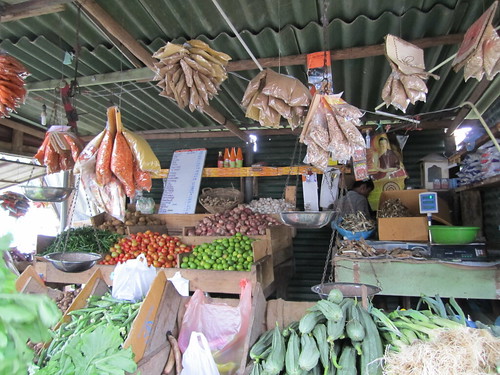
You can see they sell more than just vegetables. In the back to the left you have the essentials: garlic, onion, ginger, tomato, potato, fresh chillies and lime. To the right, you can see they also sell a variety of dried fish including maldive fish (which is like katsuobushi), an essential ingredient in vegetable curries and salads. And of course there are various spices and chilli powders hanging in packets. In fact, it's a one-stop shop for curries.
One of the more exotic vegetables you get in Sri Lanka is the banana flower. It's a beautiful purply red colour and is the size of a medium papaya. It's usually chopped finely and cooked as a curry. Here you can see it flanked by some kind of root vegetable on the right and white cucumbers on the left, spring onions above and long beans next to it.
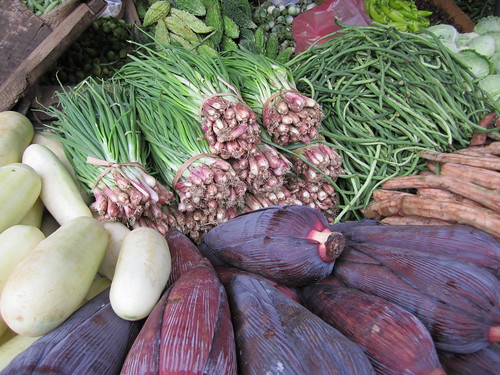
There's also bread fruit which looks a little like a cross between a jack fruit and a durian, similar to a small green football. This is also curried and has a colour and texture similar to young bamboo shoots (
takenoko).
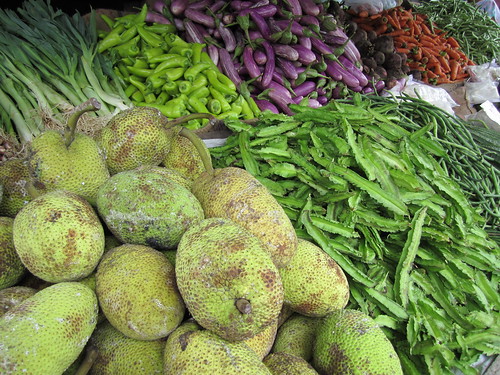 Next to the bread fruit (above) is one of my favourite vegetables eaten as a milky curry. I think it's a type of gourd similar to the ridge gourd. And just above it is a mound of pale purple aubergines.
Next to the bread fruit (above) is one of my favourite vegetables eaten as a milky curry. I think it's a type of gourd similar to the ridge gourd. And just above it is a mound of pale purple aubergines.
Leeks sandwiched between ridge gourds and snake gourds. Green bananas on the right.
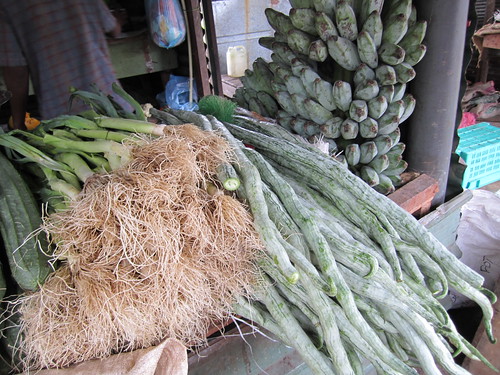
Baby bitter gourds flanked by ridge gourds and sour mangoes. The baby bitter gourds are not as bitter as the
usual ones. And the sour mangoes are also cooked in a hot/sour/sweetish curry that tastes a bit like chutney.
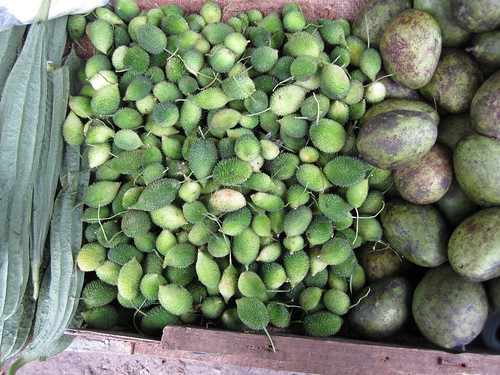
The baby bitter gourds look a little like baby hedgehogs.

I first thought this was a pile of discarded, dried-out leaves until I took a closer look and found they were bundles of herbs for curry.
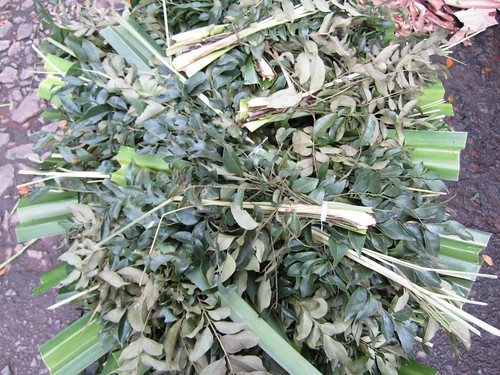
There's curry leaf (
karapincha), lemongrass and
rampe (
pandan leaf); all essential ingredients in a proper
Sri Lankan curry. I was a bit surprised at the inclusion of lemongrass but my father assures me that it's normal. I guess it could take the place of kaffir lime leaves which are often used in curries.

And of course no vegetable shop can be without coconuts! We normally crack the coconut open with a hammer and then grate it with a traditional grater attached to a table.
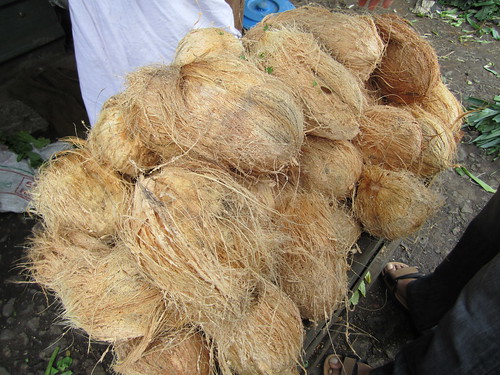
We bought a huge bag of vegetables, then we headed off to what my father says is the most important shop of all:
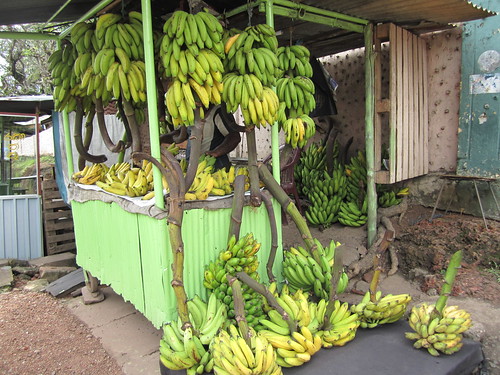
Sri Lankans cannot live without bananas. Apparently they are happiest when they have a cup of sweet tea in one hand and a banana in the other. There are so many varieties and are available all year round. My favourites are the sour banana (which isn't all that sour) and katta kolomba which is sweet and sour at the same time. So different from the bananas we get in London.
I had
mentioned previously a little bit about betel leaves. As I had been going on about how I wanted to try them properly, my father popped out to get me a small bundle.

Betel leaves are traditionally given as offerings in ceremonies such as weddings. They are also presented to Buddhist priests in temples. Although most often used as a stimulant, it is said to have various ayurvedic properties and have been in use for over 2000 years in the Indian subcontinent.
My father doesn't chew betel himself and admitted he has an aversion to them because as a child, one of his chores was to collect all the betel leaves people left behind as offerings for his grandfather (who was an ayurvedic doctor and village headman) and which his grandfather sold. So he can't stand the smell. I, on the other hand, love the smell. I've only had betel leaf in the Indian manner, as
paan, filled with spices, coconut and sugar/honey, which you eat as a palate cleanser and breath freshener. I've never chewed it like tobacco. So I opened the packet and found the following:
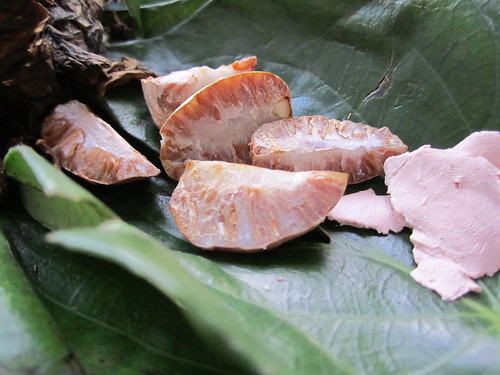
Surprisingly, it came with chewing tobacco plus the betel nut (areca nut) and a small slab of slaked lime paste. You are supposed to make a little parcel with a little bit of each ingredient and chew. I left out the tobacco (as it looked quite gross) and just put a tiny bit of the lime (which is a stimulant) and a big piece of leaf and nut to chew.
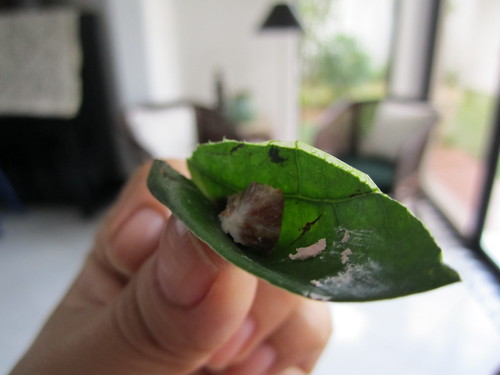
I was a bit apprehensive as I chewed, but it just tasted very green. I was also expecting my mouth and saliva to turn red as blood, but I don't think I put enough of the lime so my mouth stayed green. It wasn't all that good, just very green. So I couldn't even spit out red liquid like all the people chewing betel on the streets. Would I try it again? Maybe. But I think I prefer eating it the Indian way which tastes much, much better.
 My parents do their daily and weekly shopping at the vegetable shop just down the road from their house. The thing about South Asian countries is that even though their produce is fresher than fresh, but because of the heat, things go bad very quickly (who wants a bunch of wilted greens?). The main market day is Sunday but we try and avoid the crowds and do our shopping during the week. Most local shops are located on the roadside and look like this:
My parents do their daily and weekly shopping at the vegetable shop just down the road from their house. The thing about South Asian countries is that even though their produce is fresher than fresh, but because of the heat, things go bad very quickly (who wants a bunch of wilted greens?). The main market day is Sunday but we try and avoid the crowds and do our shopping during the week. Most local shops are located on the roadside and look like this:
 You can see they sell more than just vegetables. In the back to the left you have the essentials: garlic, onion, ginger, tomato, potato, fresh chillies and lime. To the right, you can see they also sell a variety of dried fish including maldive fish (which is like katsuobushi), an essential ingredient in vegetable curries and salads. And of course there are various spices and chilli powders hanging in packets. In fact, it's a one-stop shop for curries.
One of the more exotic vegetables you get in Sri Lanka is the banana flower. It's a beautiful purply red colour and is the size of a medium papaya. It's usually chopped finely and cooked as a curry. Here you can see it flanked by some kind of root vegetable on the right and white cucumbers on the left, spring onions above and long beans next to it.
You can see they sell more than just vegetables. In the back to the left you have the essentials: garlic, onion, ginger, tomato, potato, fresh chillies and lime. To the right, you can see they also sell a variety of dried fish including maldive fish (which is like katsuobushi), an essential ingredient in vegetable curries and salads. And of course there are various spices and chilli powders hanging in packets. In fact, it's a one-stop shop for curries.
One of the more exotic vegetables you get in Sri Lanka is the banana flower. It's a beautiful purply red colour and is the size of a medium papaya. It's usually chopped finely and cooked as a curry. Here you can see it flanked by some kind of root vegetable on the right and white cucumbers on the left, spring onions above and long beans next to it.
 There's also bread fruit which looks a little like a cross between a jack fruit and a durian, similar to a small green football. This is also curried and has a colour and texture similar to young bamboo shoots (takenoko).
There's also bread fruit which looks a little like a cross between a jack fruit and a durian, similar to a small green football. This is also curried and has a colour and texture similar to young bamboo shoots (takenoko).
 Next to the bread fruit (above) is one of my favourite vegetables eaten as a milky curry. I think it's a type of gourd similar to the ridge gourd. And just above it is a mound of pale purple aubergines.
Leeks sandwiched between ridge gourds and snake gourds. Green bananas on the right.
Next to the bread fruit (above) is one of my favourite vegetables eaten as a milky curry. I think it's a type of gourd similar to the ridge gourd. And just above it is a mound of pale purple aubergines.
Leeks sandwiched between ridge gourds and snake gourds. Green bananas on the right.
 Baby bitter gourds flanked by ridge gourds and sour mangoes. The baby bitter gourds are not as bitter as the usual ones. And the sour mangoes are also cooked in a hot/sour/sweetish curry that tastes a bit like chutney.
Baby bitter gourds flanked by ridge gourds and sour mangoes. The baby bitter gourds are not as bitter as the usual ones. And the sour mangoes are also cooked in a hot/sour/sweetish curry that tastes a bit like chutney.
 The baby bitter gourds look a little like baby hedgehogs.
The baby bitter gourds look a little like baby hedgehogs.
 I first thought this was a pile of discarded, dried-out leaves until I took a closer look and found they were bundles of herbs for curry.
I first thought this was a pile of discarded, dried-out leaves until I took a closer look and found they were bundles of herbs for curry.
 There's curry leaf (karapincha), lemongrass and rampe (pandan leaf); all essential ingredients in a proper Sri Lankan curry. I was a bit surprised at the inclusion of lemongrass but my father assures me that it's normal. I guess it could take the place of kaffir lime leaves which are often used in curries.
There's curry leaf (karapincha), lemongrass and rampe (pandan leaf); all essential ingredients in a proper Sri Lankan curry. I was a bit surprised at the inclusion of lemongrass but my father assures me that it's normal. I guess it could take the place of kaffir lime leaves which are often used in curries.
 And of course no vegetable shop can be without coconuts! We normally crack the coconut open with a hammer and then grate it with a traditional grater attached to a table.
And of course no vegetable shop can be without coconuts! We normally crack the coconut open with a hammer and then grate it with a traditional grater attached to a table.
 We bought a huge bag of vegetables, then we headed off to what my father says is the most important shop of all:
We bought a huge bag of vegetables, then we headed off to what my father says is the most important shop of all:
 Sri Lankans cannot live without bananas. Apparently they are happiest when they have a cup of sweet tea in one hand and a banana in the other. There are so many varieties and are available all year round. My favourites are the sour banana (which isn't all that sour) and katta kolomba which is sweet and sour at the same time. So different from the bananas we get in London.
I had mentioned previously a little bit about betel leaves. As I had been going on about how I wanted to try them properly, my father popped out to get me a small bundle.
Sri Lankans cannot live without bananas. Apparently they are happiest when they have a cup of sweet tea in one hand and a banana in the other. There are so many varieties and are available all year round. My favourites are the sour banana (which isn't all that sour) and katta kolomba which is sweet and sour at the same time. So different from the bananas we get in London.
I had mentioned previously a little bit about betel leaves. As I had been going on about how I wanted to try them properly, my father popped out to get me a small bundle.
 Betel leaves are traditionally given as offerings in ceremonies such as weddings. They are also presented to Buddhist priests in temples. Although most often used as a stimulant, it is said to have various ayurvedic properties and have been in use for over 2000 years in the Indian subcontinent.
My father doesn't chew betel himself and admitted he has an aversion to them because as a child, one of his chores was to collect all the betel leaves people left behind as offerings for his grandfather (who was an ayurvedic doctor and village headman) and which his grandfather sold. So he can't stand the smell. I, on the other hand, love the smell. I've only had betel leaf in the Indian manner, as paan, filled with spices, coconut and sugar/honey, which you eat as a palate cleanser and breath freshener. I've never chewed it like tobacco. So I opened the packet and found the following:
Betel leaves are traditionally given as offerings in ceremonies such as weddings. They are also presented to Buddhist priests in temples. Although most often used as a stimulant, it is said to have various ayurvedic properties and have been in use for over 2000 years in the Indian subcontinent.
My father doesn't chew betel himself and admitted he has an aversion to them because as a child, one of his chores was to collect all the betel leaves people left behind as offerings for his grandfather (who was an ayurvedic doctor and village headman) and which his grandfather sold. So he can't stand the smell. I, on the other hand, love the smell. I've only had betel leaf in the Indian manner, as paan, filled with spices, coconut and sugar/honey, which you eat as a palate cleanser and breath freshener. I've never chewed it like tobacco. So I opened the packet and found the following:
 Surprisingly, it came with chewing tobacco plus the betel nut (areca nut) and a small slab of slaked lime paste. You are supposed to make a little parcel with a little bit of each ingredient and chew. I left out the tobacco (as it looked quite gross) and just put a tiny bit of the lime (which is a stimulant) and a big piece of leaf and nut to chew.
Surprisingly, it came with chewing tobacco plus the betel nut (areca nut) and a small slab of slaked lime paste. You are supposed to make a little parcel with a little bit of each ingredient and chew. I left out the tobacco (as it looked quite gross) and just put a tiny bit of the lime (which is a stimulant) and a big piece of leaf and nut to chew.
 I was a bit apprehensive as I chewed, but it just tasted very green. I was also expecting my mouth and saliva to turn red as blood, but I don't think I put enough of the lime so my mouth stayed green. It wasn't all that good, just very green. So I couldn't even spit out red liquid like all the people chewing betel on the streets. Would I try it again? Maybe. But I think I prefer eating it the Indian way which tastes much, much better.
I was a bit apprehensive as I chewed, but it just tasted very green. I was also expecting my mouth and saliva to turn red as blood, but I don't think I put enough of the lime so my mouth stayed green. It wasn't all that good, just very green. So I couldn't even spit out red liquid like all the people chewing betel on the streets. Would I try it again? Maybe. But I think I prefer eating it the Indian way which tastes much, much better.



Comments (2)
Such strange gifts of nature – very interesting, Sakura! Chewing betel is disgusting though, ew.
It’s very seasonal there so there are lots more veg and fruits that you can’t get in Europe. I even saw small pink bananas which were real but only for decoration! And about the betel, when in Rome, do as the Romans do, right?